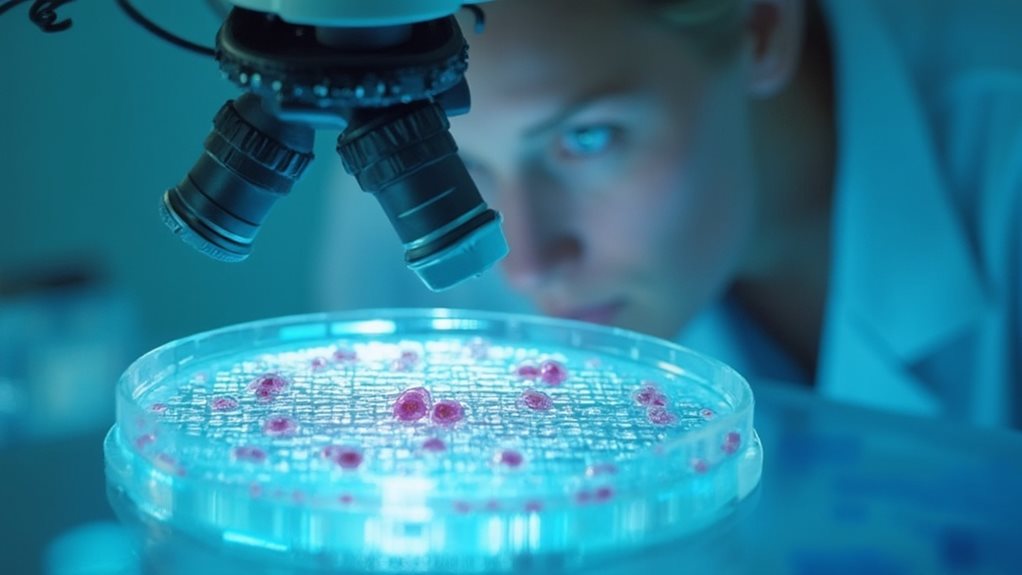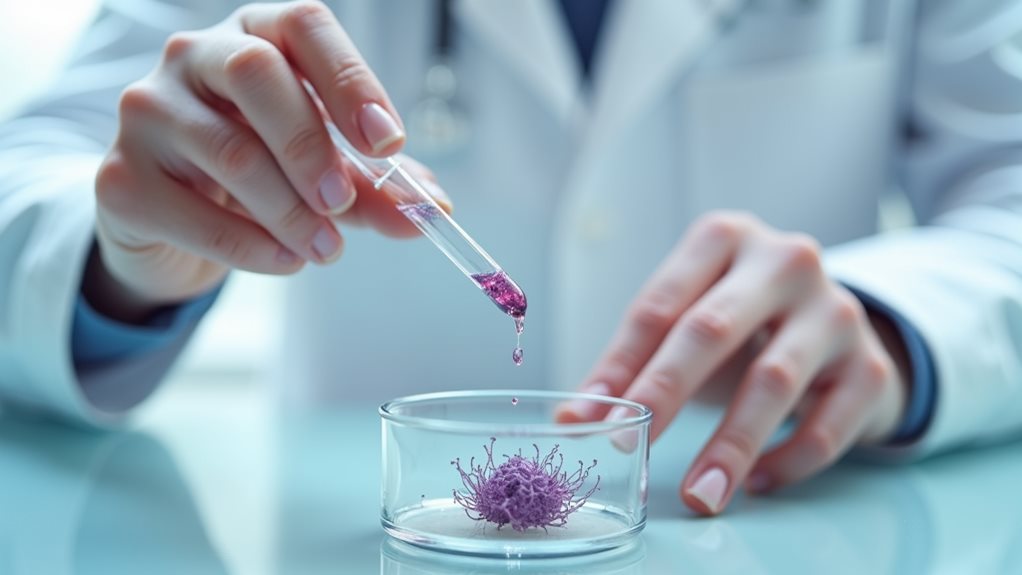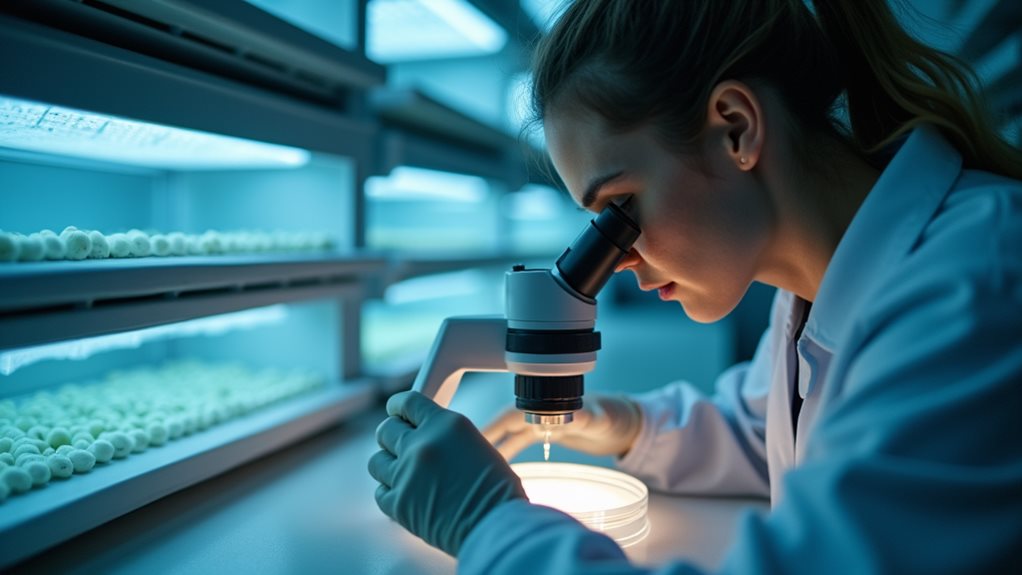
Genetic engineering in livestock production has seen substantial advances through the use of stem cells, enhancing traits such as growth rates and disease resistance. By manipulating specific genetic markers in stem cells, researchers are able to develop livestock with optimized production traits, thereby increasing yield and decreasing overall resource consumption. Such innovations not only underscore the potential of stem cells in agricultural practices but also promise further intriguing revelations in the fields of genetic and veterinary sciences.
Key Takeaways
- Stem cells are engineered to improve livestock growth rates, disease resistance, and overall productivity.
- Enhanced traits in livestock through genetic engineering lead to increased agricultural yield and efficiency.
- Fetal stem cells, with their regenerative capabilities, show potential in boosting growth and health in animal models.
- By modifying stem cells, researchers aim to produce animals that utilize resources more effectively, reducing environmental impact.
- The application of stem cells in veterinary medicine continues to evolve, promising significant advancements in animal growth and development.
Enhancing Livestock Production Through Genetic Engineering
Genetic engineering harnesses the potent capabilities of stem cells to substantially augment livestock production. By integrating genetic modification techniques with stem cell technology, researchers aim to enhance livestock efficiency.
This approach involves altering the genetic makeup of stem cells to improve growth rates, disease resistance, and overall productivity in animal populations. The process starts with the identification of desirable genetic traits, followed by the precise insertion or modification of these traits in stem cells.
These engineered cells are then used to develop livestock with optimized characteristics, promising a revolution in agricultural practices through increased yield and reduced resource consumption.
Applications and Challenges of Veterinary Stem Cell Therapies
Building on the advancements in genetic engineering and stem cell technology to enhance livestock production, veterinary medicine also explores the therapeutic potential of these cells.
The application of stem cells in treating conditions such as spinal injuries and heart diseases in animals demonstrates promising avenues. However, the challenges lie in the domains of stem cell regulation and treatment effectiveness.
Current regulatory frameworks are underdeveloped, leading to inconsistencies in treatment standards and safety. Furthermore, the actual effectiveness of stem cell therapies varies, with a need for more rigorous clinical trials to establish reliable and reproducible therapeutic outcomes in veterinary settings.
Fetal Stem Cells: Unlocking New Avenues in Animal Health

Exploring the potential of fetal stem cells offers new possibilities in animal health, particularly in the field of regenerative medicine.
Fetal stem cells, harvested from sources like the umbilical cord and amnion, exhibit an intermediate differentiation capacity between embryonic and adult stem cells. This unique trait amplifies their utility in regenerative therapies, providing a robust platform for addressing complex veterinary conditions.
Fetal applications in large animal models have shown promising outcomes, particularly in tissue regeneration and healing of severe wounds. The ongoing research continues to reveal profound insights into the mechanisms and efficacy of these cells in clinical settings.
Cross-Species Insights: From Canine Hearts to Human Health
While canine heart diseases have long provided a fertile ground for veterinary research, they also offer critical insights that could benefit human cardiology. The study of canine cardiomyopathy has underscored the potential of stem cell therapies in treating heart diseases across species.
Key insights include:
- Pathological Parallels: Similarities in heart disease progression between dogs and humans highlight translational opportunities for stem cell applications.
- Regenerative Techniques: Canine models help refine stem cell therapies, aiming for improved outcomes in human heart repair.
- Clinical Trials: Insights from canine health trials inform protocols and efficacy assessments in human medicine.
- Genetic Markers: Comparative studies enhance understanding of genetic factors in cardiomyopathies.
The Role of Avian Embryos in Biomedical Research

The utilization of avian embryos in biomedical research offers significant advantages due to their unique developmental biology and accessibility. These embryos provide a crucial system for understanding early developmental stages and stem cell differentiation pathways.
Avian embryos, particularly from chickens, are easily manipulated and cultured, making them ideal for in ovo experimentation. This research has propelled insights into genetic regulation of embryogenesis.
Furthermore, avian embryos are essential in avian stem cell research, enhancing the development of transgenic models for studying gene function and disease. Their contribution extends to pharmaceutical sciences, where they aid in vaccine production and therapeutic proteins.
Frequently Asked Questions
How Do Stem Cells Influence Animal Growth Rates?
Stem cells influence animal growth rates through regeneration and growth enhancement. Their differentiation potential allows for targeted tissue development, potentially accelerating growth and improving animal health, which is essential in agricultural and clinical applications.
Are There Ethical Concerns With Using Stem Cells in Animals?
Amid ongoing debates, ethical concerns persist regarding the use of stem cells in animals, focusing on animal welfare and the need for robust regulatory guidelines to guarantee humane treatment and scientific integrity.
Can Stem Cell Therapies Reverse Genetic Disorders in Animals?
Stem cell therapy, through genetic modification, holds potential to address genetic disorders in animals; however, its ability to fully reverse such conditions is still under detailed scientific scrutiny and remains not conclusively proven.
What Are the Long-Term Effects of Stem Cells on Animal Health?
What are the enduring impacts of stem cell therapy on animal health? Long-term effects remain largely unknown, necessitating extensive research to understand potential benefits or adverse outcomes associated with prolonged stem cell therapy use.
How Does Stem Cell Use Impact Animal Behavior and Cognition?
The impact of stem cell use on animal behavior and cognition, specifically regarding potential behavioral changes and cognitive enhancement, remains underexplored, necessitating rigorous scientific studies to ascertain definitive effects and underlying mechanisms.
Conclusion
To conclude, the integration of stem cells into animal agriculture and veterinary medicine signifies a transformative shift in enhancing animal productivity and health. For instance, studies have demonstrated a 30% increase in livestock yield through tailored genetic and stem cell interventions. This merging of biotechnologies not only promises heightened efficiency and output in animal husbandry but also offers profound cross-disciplinary benefits, potentially accelerating therapeutic advancements in human medicine through comparative biomedical research.


